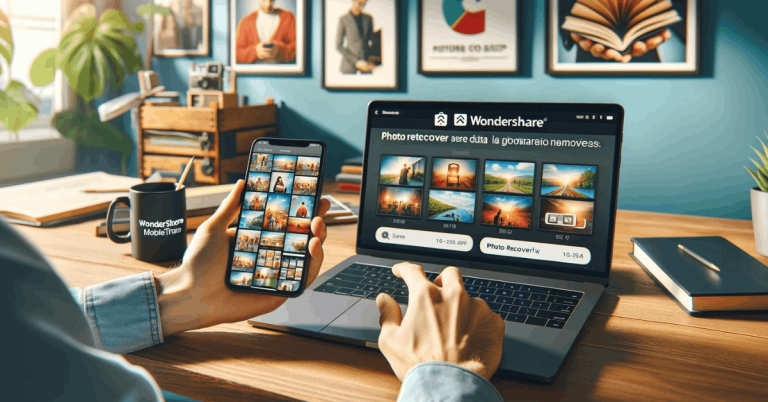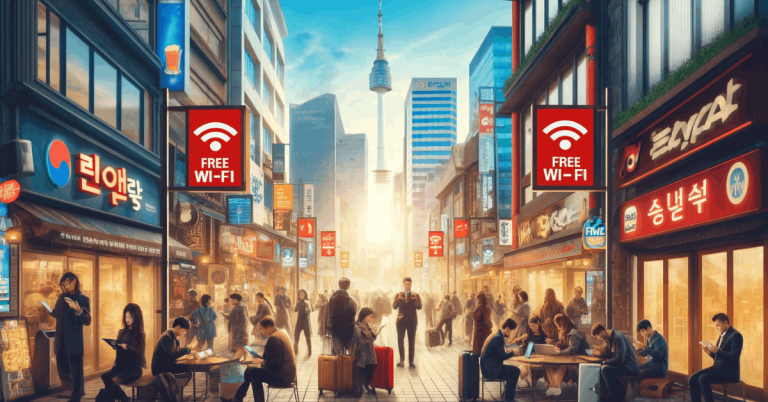The internet is essential in today’s world, as it connects people globally.
Free WiFi hotspots provide quick access to the internet, improve communication, and enhance your online experience.
For details on locating free WiFi hotspots, refer to this guide.
Free WiFi Hotspot
A free WiFi hotspot is a public location where you can access the internet at no cost. This is particularly useful if you frequently use large amounts of data or find mobile data plans like 4G or 5G too expensive.
If you’re using 3G, switching to a WiFi hotspot can speed up your internet. While some places, like internet cafes, might ask for a fee for faster internet access, many public hotspots provide a speed that’s adequate for most of your online needs.
Where to Find a Public Free WiFi Hotspot?
There are a couple of strategies to use if you’re looking for a good free hotspot right now.
1. Key Locations for Free WiFi Access
Free WiFi is available in many establishments and public places. Notable spots include restaurants and cafes like Starbucks.
Public areas such as libraries, universities, train stations, and parks also provide free WiFi. Keep an eye out locally, and you’re likely to find a free service. Companies like Starbucks, McDonald’s, and Burger King offer free WiFi to enhance customer experience.
Additionally, places like coffee shops, libraries, shopping centers, and transportation hubs commonly have WiFi, supporting connectivity in everyday life. Specific Venues with Free WiFi:
- Public Libraries: Offer free WiFi, facilitating various online activities.
- Airports: Feature free WiFi to keep travelers connected.
- Accommodations: Hotels and hostels provide WiFi for guests.
- Public Transport: Free WiFi available on city buses and trains.
- Public Spaces: WiFi in parks and squares supports outdoor connectivity.
- Educational Institutions: WiFi for students and visitors at universities.
- Shopping Malls and Community Centers: Provide WiFi for visitors.
- Fast Food Chains: Like McDonald’s and Burger King offer free WiFi.
- Cultural Venues: Museums and theaters enhance visits with WiFi.
- Transportation Hubs and City Initiatives: Support connectivity projects.
- Events and Coworking Spaces: Temporary and permanent WiFi solutions.
- Tourist Centers: Assist travelers with WiFi access.
2. Use a Wi-Fi Map App
For on-the-go internet access, using a WiFi map app is efficient. Apps like Wifi map, Wifi finder, and Wifi analyzer help locate hotspots and provide information on internet speeds.
These apps display hotspots nearby and feature offline map downloads for convenient access.
Exploring The Wifi Map App
WiFi Map locates and displays nearby WiFi hotspots, which you can reach using your device’s GPS.
This crowdsourced app allows users to add both public and private WiFi connections, making them accessible to others. Hotspots are often found at public places like restaurants and cafes.
You can easily share these WiFi details on social media, including Facebook, Instagram, and Twitter, aiding your friends in connecting quickly.
Offline Maps and Additional Features
For enhanced utility, save the maps so you can use them offline. By storing a city’s map, you maintain access to hotspot information even without an internet connection, which is especially useful for frequent travelers looking to conserve data usage.
Additionally, the app features a speed test tool to assess connection performance, ensuring you avoid inefficient networks. This tool is invaluable for tasks that require robust internet speed, such as file downloads or streaming.
Upgrading to WiFi Map Pro
Are you tired of ads and seeking more from your app? Consider switching to WiFi Map Pro. This enhanced version removes disruptive ads and introduces features absent in the basic version.
Key benefits of the Pro version include access to offline maps and multiple VPN servers. It allows up to five simultaneous VPN connections under a single account, enabling various devices to access the internet if logged into this account.
The annual subscription for WiFi Map Pro costs $29.99. However, a current promotion offers a 20% discount, reducing costs to $23.99 per year.
Privacy Considerations
Installing any app, including WiFi Map Pro, necessitates understanding the information collected by the developer. WiFi Map LLC gathers data concerning users and their devices.
This includes your email address, profiles from Google, Facebook, or other networks, as well as your age range, country, language, and timezone.
Additionally, it collects details about your device such as make, model, and operating system, along with your mobile carrier and network performance data.
The eSIM from WiFi Map
WiFi Map’s eSIM provides internet directly, eliminating the need for Wi-Fi and roaming. Select a plan, scan a QR code, and connect instantly.
Each 30-day plan, like the 1 GB option, supports extensive use—from messaging and emails to web browsing and navigation.
Prices vary: €4.99 in Europe, €9.99 in Australia and New Zealand, and €32.99 in Africa and Latin America.
Compatibility
The eSIM is compatible with specific smartphones like the Samsung Galaxy S20 series, Google Pixel, and iPhone 11 and 12 models. Your phone must be unlocked to use the eSIM, as network-locked phones will not support it.
Additionally, be aware of possible geo-restrictions in places like China, where iPhones cannot use eSIMs, and in Hong Kong and Macau, where only certain iPhone models are eSIM-compatible.
How to Download the WiFi Map Pro App
Here’s a streamlined guide to downloading the WiFi Map Pro app, formatted in steps for clarity:
Android Users:
- Open the Google Play Store on your device.
- Search for “Free WiFi Passwords, Offline maps & VPN. WiFi Map.”
- Locate the correct app and tap on the ‘Install’ button to start the download.
- Once downloaded, follow the on-screen instructions to set up your account.
iOS Users:
- Open the Apple App Store on your device.
- Search for “WiFi Map TripBox: Find Hotspot.”
- Tap ‘Get’ to initiate the download.
- If prompted, allow the necessary permissions during the installation process.
- After installation, open the app to begin using it.
Why Use Local Free WiFi Hotspots?
Searching for local free WiFi hotspots instead of relying on your cellular network can be advantageous.
- Cost Reduction: The primary benefit of free WiFi is the lower expense. It allows you to navigate the internet and perform tasks without consuming your mobile data, which saves money.
- Weak Cellular Signals: While traveling, you might encounter poor cellular reception. In these cases, free WiFi hotspots serve as a vital alternative for staying online and accomplishing your activities.
- SIM Card Troubles: If you have issues with your SIM card affecting both internet and phone services, free WiFi hotspots are crucial to keep your online activities uninterrupted.
Countries With the Most Public Free WiFi Hotspots
Globally, around half a billion free Wi-Fi hotspots facilitate internet access, but their distribution varies widely.
Russia stands out in Europe with 276,439 hotspots, yet due to its large population of 144 million, the ratio of people to hotspots is higher compared to smaller nations. Wi-Fi speeds also differ significantly among these hotspots.
If high hotspot density is important to you, the leading countries are:
- France: 2.8 people per public hotspot
- Belgium: 2.9 people per public hotspot
- Denmark: 4.3 people per public hotspot
- Austria: 4.6 people per public hotspot
- South Korea: 5.6 people per hotspot
For the fastest Wi-Fi, consider:
- Lithuania
- Croatia
- Estonia
- Ireland
- Romania
Both Europe and East Asia, particularly South Korea and Japan, are excellent travel destinations if you prioritize easy and fast internet access.
France and Belgium rank highest in hotspot availability per capita, while Lithuania and Croatia rank at the top for speed.
Conclusion
In the digital age, the fusion of education, economic empowerment, and social inclusion is evident at free WiFi hotspots.
Every link, global or local, fosters a more connected and enhanced world.
More than just connectivity, free WiFi shapes a future where every person flourishes, powered by unlimited internet access.
Read in another language
- Español: Encuentra puntos de Wi-Fi gratuito en tu área: Consejos rápidos
- Bahasa Indonesia: Temukan Titik Hotspot Wi-Fi Gratis di Area Anda: Tips Cepat
- Bahasa Melayu: Cari Hotspot Wi-Fi Percuma di Kawasan Anda: Tip Cepat
- Čeština: Vyhledejte zdarma dostupná místa s Wi-Fi v oblasti: Rychlé tipy
- Dansk: Find Gratis Wi-Fi Hotspots i Dit Område: Hurtige Tips
- Deutsch: Suchen Sie nach kostenlosen Wi-Fi-Hotspots in Ihrer Umgebung: Schnelle Tipps
- Eesti: Leidke tasuta Wi-Fi levialad oma piirkonnas: kiired näpunäited
- Français: Repérez les points d’accès Wi-Fi gratuits dans votre région : Conseils rapides
- Hrvatski: Pronađite besplatne Wi-Fi pristupne točke u svom području: Brzi savjeti [ww]
- Italiano: Trovare Hotspot Wi-Fi Gratuiti nella Tua Zona: Consigli Veloci
- Latviešu: Atrast bezmaksas Wi-Fi karstās vietas jūsu apgabalā: ātras lietošanas padomi
- Lietuvių: Suraskite nemokamas belaidžio interneto vietas savo rajone: Greiti patarimai
- Magyar: Keressen ingyenes Wi-Fi-hotspotokat a környéken: Gyors tippek
- Nederlands: Vind gratis Wi-Fi-hotspots in jouw omgeving: Snelle tips
- Norsk: Finn gratis Wi-Fi-hotspot i ditt område: Raske tips
- Polski: Znajdź Darmowe Hotspoty Wi-Fi w Twojej Okolicy: Szybkie wskazówki
- Português: Encontre Pontos de Wi-Fi Grátis em Sua Região: Dicas Rápidas
- Română: Localizați punctele de acces gratuite la Wi-Fi din zona dvs.: Sfaturi rapide
- Slovenčina: Nájdite bezplatné Wi-Fi miesta vo vašej oblasti: Rýchle tipy
- Suomi: Etsi ilmaisia Wi-Fi-hotspotteja alueeltasi: Nopeita vinkkejä
- Svenska: Hitta gratis Wi-Fi-hotspots i ditt område: Snabba tips
- Tiếng Việt: Tìm Điểm Phát Wi-Fi Miễn Phí ở Khu Vực Của Bạn: Mẹo Nhanh
- Türkçe: Alanınızdaki Ücretsiz Wi-Fi Noktalarını Bulma: Hızlı İpuçları
- Ελληνικά: Εντοπισμός Δωρεάν Σημείων Wi-Fi στην Περιοχή Σας: Γρήγορες Συμβουλές
- български: Намерете безплатни Wi-Fi точки във вашето район: Бързи съвети
- Русский: Найти бесплатные Wi-Fi точки доступа в вашем районе: быстрые советы
- עברית: איתור נקודות Wi-Fi חופשיות באזור שלך: טיפים מהירים
- اردو: آپ کے علاقے میں مفت وائی فائی ہاٹسپاٹس تلاش کریں: تیز ٹپس
- العربية: ابحث عن نقاط اتصال مجانية بشبكة الواي فاي في منطقتك: نصائح سريعة
- فارسی: رویتازهای Wi-Fi رایگان در منطقه خود را پیدا کنید: نکات سریع
- हिन्दी: अपने क्षेत्र में मुफ्त Wi-Fi हॉटस्पॉट्स खोजें: तेज़ टिप्स
- ภาษาไทย: ค้นหาจุดให้บริการ Wi-Fi ฟรีในพื้นที่ของคุณ: คำแนะนำด่วน
- 日本語: あなたのエリアで無料のWi-Fiホットスポットを見つける方法:簡単なヒント
- 简体中文: 在您的地区查找免费Wi-Fi热点:快速提醒
- 繁體中文: 在您的地區尋找免費Wi-Fi熱點:快速技巧
- 한국어: 근처 무료 Wi-Fi 핫스팟 찾기: 빠른 팁





